Piaffe: The Movements
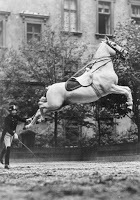 Capriole on the lines.Forging Piaffe's world on the page for the reader is crucial to the immersion, suspension of disbelief. One of the greatest challenges for me as the writer fell in the realm of the insigni, specifically their warfare tactics and strategies.
Capriole on the lines.Forging Piaffe's world on the page for the reader is crucial to the immersion, suspension of disbelief. One of the greatest challenges for me as the writer fell in the realm of the insigni, specifically their warfare tactics and strategies.Once upon a time, before tanks, mounted cavalry units were the single most intimidating force on the battlefield. A well trained steed could scatter infantry with a kick, and was a force to be reckoned with -- wielding hooves, teeth, and its greater weight against adversaries at its rider's behest.
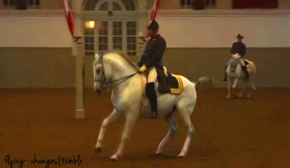 Capriole under saddle in action.The remnants of those techniques are preserved in the militaristic discipline with which horsemanship is taught to both equine and human pupils at the Spanish Riding School in Vienna, Austria.
Capriole under saddle in action.The remnants of those techniques are preserved in the militaristic discipline with which horsemanship is taught to both equine and human pupils at the Spanish Riding School in Vienna, Austria.For those who aren't familiar with classical dressage, describing a horse's movements with terms more complex than jog or gallop may prove challenging. So when portraying a capriole, for instance, how exactly does one proceed? It is a rear, a leap, a kick, but to witness them performed in flawless transition is to realize the power and force behind the act, and realize that it is so much more.
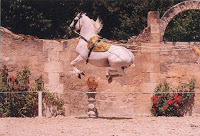 CroupadeThe Lipizzaners, as a breed and a legacy, are certainly a sight to behold. But when one takes into consideration the fact that each stallion only trains under one rider, and together that rider/horse team practices each and every day, and that these complex haute ecole movements demand musculature, physique, and intellect that few horses could dare attain in their lifetimes... suddenly their efforts and performance take on a new meaning, and the observer has a greater appreciation for what it takes to do that seemingly innocuous and quick leap-kick. It is not enough for the horse to understand what the rider wants and execute it, he must have the strength to do so with power and control, without hurting himself.
CroupadeThe Lipizzaners, as a breed and a legacy, are certainly a sight to behold. But when one takes into consideration the fact that each stallion only trains under one rider, and together that rider/horse team practices each and every day, and that these complex haute ecole movements demand musculature, physique, and intellect that few horses could dare attain in their lifetimes... suddenly their efforts and performance take on a new meaning, and the observer has a greater appreciation for what it takes to do that seemingly innocuous and quick leap-kick. It is not enough for the horse to understand what the rider wants and execute it, he must have the strength to do so with power and control, without hurting himself.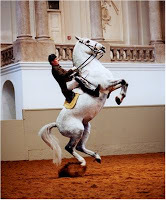 CourbetteThus it is with the insigni. They are large and powerful, more so than a horse, and yet at the same time they cannot simply throw themselves into movements without proper athletic regimens and training, not without injuring themselves or endangering the wellbeing of those around them. It is the same with any professional athlete, it is the same with any military personnel. It is, after all, a running joke among enlisted ranks that the most dangerous individual on the battlefield, or the training field, is a lieutenant with a compass.
CourbetteThus it is with the insigni. They are large and powerful, more so than a horse, and yet at the same time they cannot simply throw themselves into movements without proper athletic regimens and training, not without injuring themselves or endangering the wellbeing of those around them. It is the same with any professional athlete, it is the same with any military personnel. It is, after all, a running joke among enlisted ranks that the most dangerous individual on the battlefield, or the training field, is a lieutenant with a compass.There is precious little media circulating on the internet that I can share that is actually the Spanish Riding School pupils. If you go looking, be wary of any shots that have the horses performing in show rings, or names that flaunt "Lipizzans" without mentioning the Spanish Riding School of Vienna, Austria. Look for the brown coats, the sideways hats, and the beige and white wall of the arena in Vienna.
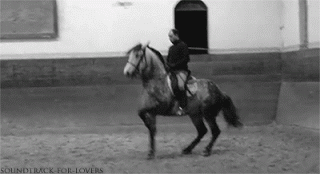 Pesade under saddle in action.
Pesade under saddle in action.
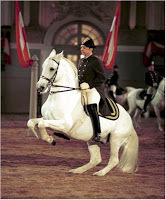 Levade under saddle.For ease of reference, I've included definitions of the various movements below. These are sourced from Wikipedia's article "Airs Above The Ground", but most classical dressage manuals will provide similar, if not identical, information. All sketched images are done by Ludwig Koch, and have been sourced from Lipizzaner: A Story of the Horses of Lipica, by Dr. Milan Dolenc, of which I own a copy (I took pictures of the sketches for you, using my mobile device).
Levade under saddle.For ease of reference, I've included definitions of the various movements below. These are sourced from Wikipedia's article "Airs Above The Ground", but most classical dressage manuals will provide similar, if not identical, information. All sketched images are done by Ludwig Koch, and have been sourced from Lipizzaner: A Story of the Horses of Lipica, by Dr. Milan Dolenc, of which I own a copy (I took pictures of the sketches for you, using my mobile device)."The pesade and levade are the first airs taught to the High School horse, and it is from these that all other airs are taught. In the pesade, the horse raises its forehand off the ground and tucks the forelegs evenly, carrying all weight on the hindquarters, to form a 45 degree angle with the ground.
"The levade was first taught at the beginning of the 20th century, asking the horse to hold a position approximately 30-35 degrees from the ground. Unlike the pesade, which is more of a test of balance, the decreased angle makes the levade an extremely strenuous position to hold, and requires a greater effort from the horse."
Croupade & Courbette:
In the croupade, the horse jumps from a raised position of the forehand (levade) straight up into the air, keeps the hind legs tucked tightly under, and remains parallel to the ground. This movement is a prerequisite to more difficult movements, the first step.
"In the courbette, the horse raises its forehand off the ground, tucks up forelegs evenly, and then jumps forward, never allowing the forelegs to touch down, in a series of "hops"."
Ballatode: In the ballatode, the horse's hind hooves are positioned so one can see its shoes if watching from behind, but the horse is not asked to kick out. When the horse demonstrates proficiency in the ballotade, the capriole is introduced.
**There is actually an error in PIAFFE, on pg 133 line 5 of the paperback or the bottom of page 62 in the PDF version, where "ballatode" should read "courbette" instead.**
Capriole:
"In the capriole (meaning leap of a goat), the horse jumps from a raised position of the forehand (levade) straight up into the air, kicks out with the hind legs, and lands more or less on all four legs at the same time. It requires an enormously powerful horse to perform correctly, and is considered the most difficult of all the airs above the ground."

Published on February 24, 2017 10:53
No comments have been added yet.



